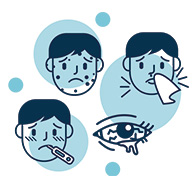Measles is one of the most easily transmitted viruses known to man. It spreads via the respiratory system – much like influenza and TB. An infected person coughs the virus and others inhale it. The measles virus remains infectious in the air up to two hours after the infectious individual has left the area.
Also called rubeola, measles can be serious and even fatal for small children. While death rates have been falling worldwide as more children receive the measles vaccine, the disease still kills more than 100,000 people a year, most under the age of five.
Measles Hotline
Call (915) 212-HELP (4357) for additional information on measles symptoms, vaccination, and potential exposure. Residents can also call 2-1-1. Available 8 AM - 5 PM Monday-Friday.
Symptoms & Prevention
 It takes an average of 10–12 days from exposure to the onset of the first symptom, which is usually fever. The measles rash doesn’t usually appear until approximately 14 days after exposure, 2–3 days after the fever begins. Unfortunately, patients are infectious for four days BEFORE rash symptoms appear to four days after they appear. As such, seemingly healthy individuals going about their business in the community can be unknowingly infecting others. Isolation of infectious individuals also helps in diminishing the subsequent infection of others.
It takes an average of 10–12 days from exposure to the onset of the first symptom, which is usually fever. The measles rash doesn’t usually appear until approximately 14 days after exposure, 2–3 days after the fever begins. Unfortunately, patients are infectious for four days BEFORE rash symptoms appear to four days after they appear. As such, seemingly healthy individuals going about their business in the community can be unknowingly infecting others. Isolation of infectious individuals also helps in diminishing the subsequent infection of others.
Vaccination remains the best form of defense against measles.
The CDC defines a measles outbreak as three or more cases within a community. We now meet that definition. Those who are concerned that they are showing signs and symptoms of a measles infection should visit their medical care provider, or those who would like more information may call 2-1-1 to receive further instructions.

